 I’m not sure exactly what’s going on in this picture, but this British gentleman a century ago obviously took radio construction seriously. The illustration appeared on the cover of the March 1925 issue of The Wireless Magazine.
I’m not sure exactly what’s going on in this picture, but this British gentleman a century ago obviously took radio construction seriously. The illustration appeared on the cover of the March 1925 issue of The Wireless Magazine.

 I’m not sure exactly what’s going on in this picture, but this British gentleman a century ago obviously took radio construction seriously. The illustration appeared on the cover of the March 1925 issue of The Wireless Magazine.
I’m not sure exactly what’s going on in this picture, but this British gentleman a century ago obviously took radio construction seriously. The illustration appeared on the cover of the March 1925 issue of The Wireless Magazine.
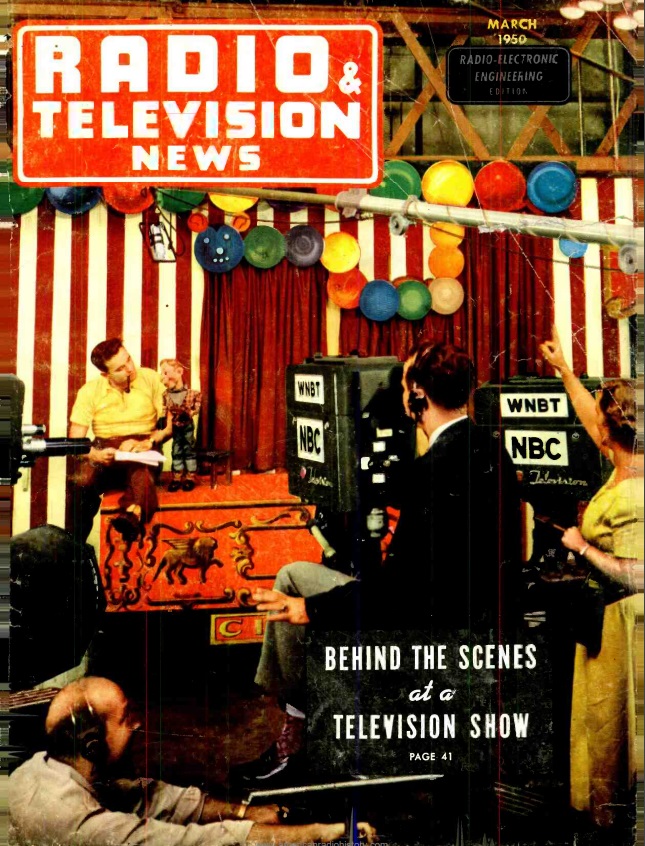 Seventy-five years ago this month, the March 1950 issue of Radio News went into details of what went on behind the scenes to put a television program on the air. The cover image is a color shot of the scene.
Seventy-five years ago this month, the March 1950 issue of Radio News went into details of what went on behind the scenes to put a television program on the air. The cover image is a color shot of the scene.
The program they were airing was Howdy Doody, on New York station WNBT.
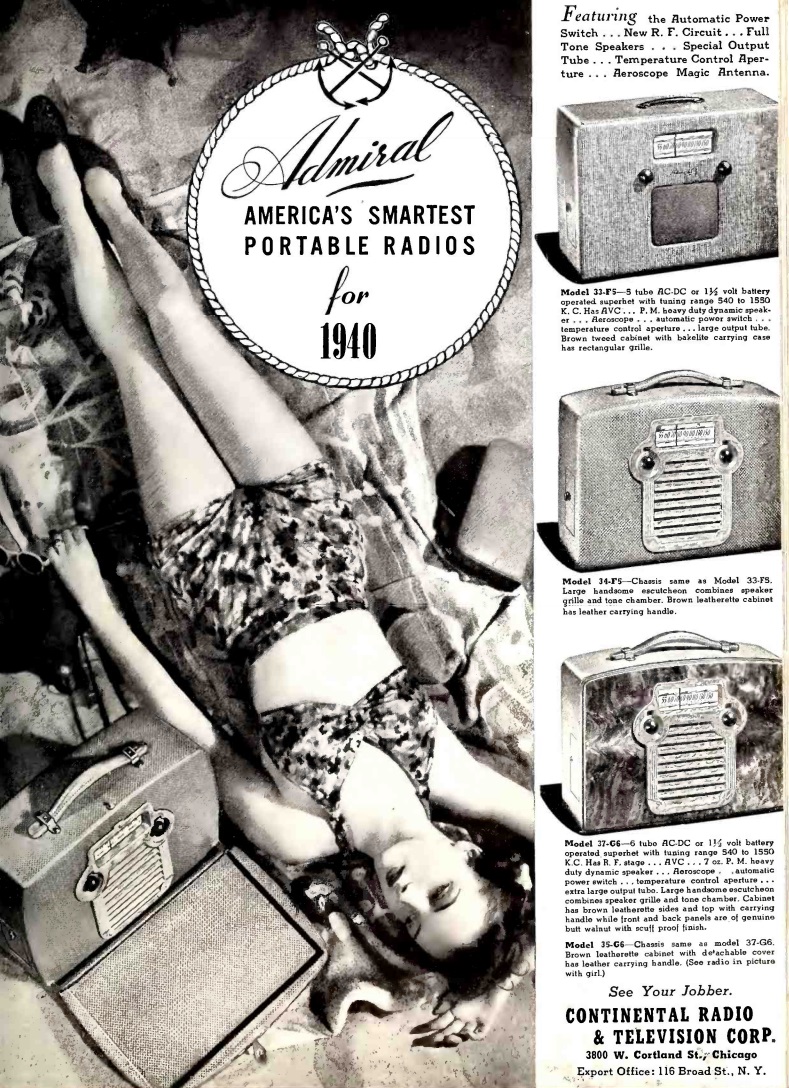 Eighty years ago this month, this broadcast listener is relaxing at the beach with her Admiral 35-G6 portable. The model shown here is the 35-G6, a six-tube set that could run on either 110 volts AC or DC, or a 1-1/2 volt battery. It was identical to the 37-G6, in a different cabinet without the cover. Also shown are models 33-F5 and 34-F5, which were five-tube sets.
Eighty years ago this month, this broadcast listener is relaxing at the beach with her Admiral 35-G6 portable. The model shown here is the 35-G6, a six-tube set that could run on either 110 volts AC or DC, or a 1-1/2 volt battery. It was identical to the 37-G6, in a different cabinet without the cover. Also shown are models 33-F5 and 34-F5, which were five-tube sets.
This ad appeared in the March 1940 issue of Radio Today.
 According to news reports, France is preparing an updated guide for its citizens for preparing for and surviving possible emergencies, including nuclear attack. Reportedly, the guide is being reviewed by the Prime Minister, and should be in the hands of the public by this summer.
According to news reports, France is preparing an updated guide for its citizens for preparing for and surviving possible emergencies, including nuclear attack. Reportedly, the guide is being reviewed by the Prime Minister, and should be in the hands of the public by this summer.
The excerpt above shows recommended contents for a family emergency kit. First on the list is a radio with spare batteries. Other items are medicines and a first aid kit, a pocketknife, non-perishable foods for all family members, including pets and infants, and warm clothing. Also on the list are a flashlight and/or candles, a charger, six liters (1.5 gallons) of water per person, and extra eyeglasses and keys for the car and house. Rounding out the list are games to pass the time, and copies of important documents.
Production of the document comes on the heels of similar preparations in the Nordic countries. There is an English versions online of the Swedish “In case of crisis or war.”
We are sure that most of our readers are prepared at least a minimal broadcast radio, which could provide lifesaving information in case of an emergency in which the Internet is unavailable. Even an inexpensive radio such as this one along with extra batteries could save your life in an emergency. (And for added flexibility, make sure your flashlight uses the same type of batteries.)
For more Emergency Preparedness pointers, see our earlier posts on the subject.
Some links on this site are affiliate links, meaning that this site earns a small commission if you make a purchase after using the link.
Bottom Line: John the Baptist ate well in the desert.
We recently received a free sample of the Holy Locust Biblical Energy Bar from the manufacturer, in exchange for an honest review. According to the Bible (Matthew 3:4), John the Baptist sustained himself in the desert on locusts and wild honey. It should be noted that the locust is perfectly kosher to eat (Leviticus 11:22).
While locusts are still eaten in some parts of the world, they have fallen out of favor in Western diets. But thanks to Israeli entrepreneur Dror Tamir, that’s changing. He founded Holy Locust to revive that lost Biblical food to feed the masses. He is in the midst of a 1000 day quest to replicate John the Baptist’s diet, and you can follow on Instagram. His company, Holy Locust, is making available locusts sourced from the banks of the River Jordan. Products include roasted whole locusts, Biblical protein shakes, and Biblical energy bars, consisting of dates, nuts, and locust protein. The protein used in the bars and shakes is locust flour, made from dried locusts ground into powder.
have fallen out of favor in Western diets. But thanks to Israeli entrepreneur Dror Tamir, that’s changing. He founded Holy Locust to revive that lost Biblical food to feed the masses. He is in the midst of a 1000 day quest to replicate John the Baptist’s diet, and you can follow on Instagram. His company, Holy Locust, is making available locusts sourced from the banks of the River Jordan. Products include roasted whole locusts, Biblical protein shakes, and Biblical energy bars, consisting of dates, nuts, and locust protein. The protein used in the bars and shakes is locust flour, made from dried locusts ground into powder.
Trying the Holy Locust Bar
Of course, as soon as we heard of this innovative food, we wanted to give it a try. In exchange for our honest review, Holy Locust provided a sample, which arrived in the mail from Israel today.
As you can see from the nutrition facts above, the bulk of the product is dates, followed by peanuts, sunflower seeds, raisins, and ground cashew. Locusts make up only 2% of the product. At first, it sounded as if they were skimping on the marquee ingredient. But when we gave it some thought, it sounded reasonable. Before being added, the locusts were dehydrated and ground up. I couldn’t find definitive information as to the water content of locusts, but according to this article, the water content of another insect is 58%. Since most living things are mostly water, this seems reasonable. The locusts are there mostly for the protein, and they are apparently an excellent source of protein. So it seems reasonable that adding 2% of practically pure protein adds a huge boost to the other ingredients.
Most importantly, the Holy Locust bars taste great! You can watch the video below of my uboxing (unwrappering) of this unique product and my first taste.
The most prominent flavor, of course, is the dates. The snack tastes not unlike many “fruit and grain” bars. There was no particular taste from the locusts, but the overall flavor did complement the dates. Again, it tastes not unlike any other fruit and grain bar you might find in the snack aisle of your favorite supermarket.
The cost of the bars is $19 for a box of six bars. If you order one or two boxes, shipping is a flat rate of $14.95. If you order three or more boxes, shipping is free. So they are not currently a cheap snack, as we’re sure you can find a comparable product at a lower price at your supermarket. But they are certainly an affordable product, if you wish to try this sustainable protein source. For the full locust experience, a small jar of whole locusts, oven roasted, is available for $12. The net weight of that product is not shown, but it appears to be about a dozen individual locusts. Other reviews I’ve seen are positive, and it looks like one of these would also be a tasty snack, suitable for a salty component of trail mix.
If you wish to cut out the middleman and capture your own locusts, you can find some recipes on this page.
No, John Didn’t Eat Carob Beans
Invariably, when Holy Locust mentions their product, some troll comes along and announces that John the Baptist wasn’t really eating locusts. I have a feeling that some of these people ordinarily consider themselves to be biblical literalists, but they’re just too squeamish to accept the fact that insects could be a food. The competing theory is that when the Bible says locust, it doesn’t really mean locust. Instead, by some convoluted logic, it really means the beans of a carob tree pod. This argument is easily put to rest. In the original Greek, the word for locust is ἀκρίδες (akrides). This word appears one other place in the New Testament, Revelation 9:3, “And out of the smoke locusts came down on the earth and were given power like that of scorpions of the earth.” It strains credulity to think that carob beans are going to one day descend from the sky and start attacking. It’s clear that when Matthew said locusts, he was talking about locusts. I’ve had carob before, and it’s a somewhat tasty alternative to chocolate. But it’s not what John the Baptist was eating.
Insects for Emergency Preparedness
Since one of the focuses of this site is on emergency preparedness, it hasn’t escaped our notice that during a food emergency, locusts and other insects might constitute an emergency food source. Among many reference works on the subject is Insects: An Edible Field Guide by Stefan Gates. While it would not be economical to stock up on locusts for use in an emergency, one might gain some confidence in the locust as a nutritious food item now. And a good way to do that is to try some from Holy Locust.
Bottom Line
We know that most of our readers are not squeamish. And even those who are squeamish might overcome this condition by trying this healthful and tasty snack. While they’re a bit pricey, keep in mind that they come with bragging rights that you ate the same thing as John the Baptist. Their high protein sustained him in the wilderness, and they’ll do so for you as well.
תהנה מהארוחה שלך!
Some links on this site, such as Amazon links, are affiliate links, meaning that this site earns a small commission if you make a purchase after using the link. Links to Holy Locust, however, are not compensated in any way.
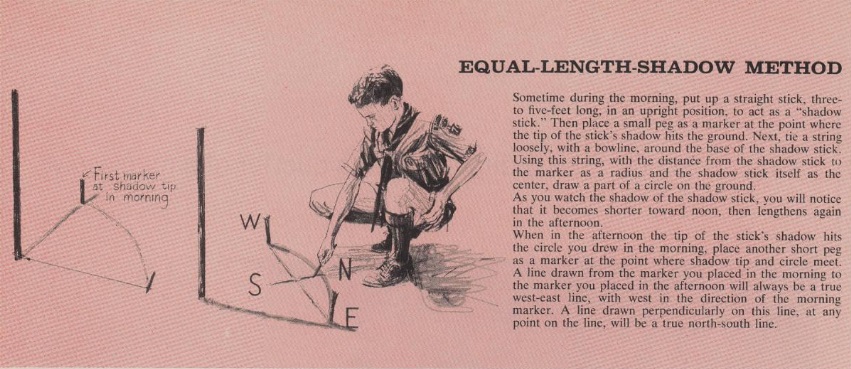 Sixty years ago this month, the March 1966 issue of Boys’ Life carried a feature by William “Green Bar Bill” Hillcourt showing a number of methods to determine the points of the compass. The method shown above, if you had the time, was exact.
Sixty years ago this month, the March 1966 issue of Boys’ Life carried a feature by William “Green Bar Bill” Hillcourt showing a number of methods to determine the points of the compass. The method shown above, if you had the time, was exact.
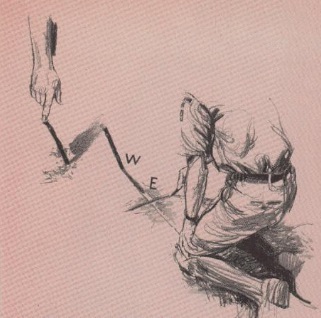 A faster but less accurate method was shown at the left. You place a straight stick in the ground so that it casts no shadow. You wait, and the inevitable shadow will be pointing approximately west. How close the method worked depended on how close you were to noon, and how close you were to the equinoxes.
A faster but less accurate method was shown at the left. You place a straight stick in the ground so that it casts no shadow. You wait, and the inevitable shadow will be pointing approximately west. How close the method worked depended on how close you were to noon, and how close you were to the equinoxes.
Sixty years ago this month, the March 1965 issue of Electronics Illustrated offered some guidance on equipment for the new ham. The magazine noted that there was a lot of information on learning the code and getting your license, but it was sparse when it came to setting up a new station.
Therefore, they showed possible stations for four different price points: $100, $250, $500, and $1000.
The hundred dollar station consisted of an Ameco AC-1T transmitter kit, along with a Lafayette KT-320 general coverage receiver. The next step up would be a Heathkit DX-60 transmitter and HR-10 receiver. There was enough in the budget for a Lafayette 9902501 VFO.
For $500, the magazine recommended an E.F. Johnson Viking Ranger II, and Lafayette HA-350 receiver.
The well heeled ham could spend $1000 on a Hallicrafters HT-37 transmitter and Drake R-4 receiver.
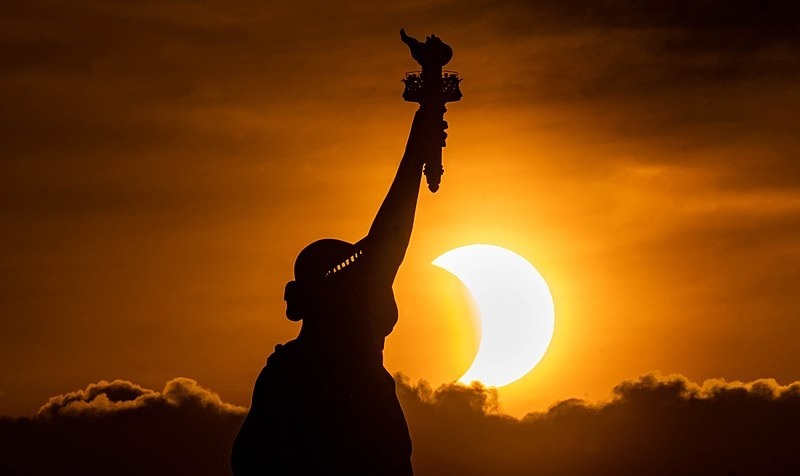 There is a partial solar eclipse taking place the morning of Saturday, March 29. In North America, it will be visible at sunrise, basically northeast of a line extending from Washington, DC, to Toronto. It will be visible in Boston, Montreal, Quèbec City, and throughout Vermont, New Hampshire, Maine, New Brunswick, Nova Scotia, and Newfoundland. In most of Western Europe, it will be visible in the late morning. To find the information at your location, you can use the map found at this link.
There is a partial solar eclipse taking place the morning of Saturday, March 29. In North America, it will be visible at sunrise, basically northeast of a line extending from Washington, DC, to Toronto. It will be visible in Boston, Montreal, Quèbec City, and throughout Vermont, New Hampshire, Maine, New Brunswick, Nova Scotia, and Newfoundland. In most of Western Europe, it will be visible in the late morning. To find the information at your location, you can use the map found at this link.
This eclipse is “just” a partial eclipse, so if you didn’t know anything was happening, you might miss it. But it’s still an interesting phenomenon.
But in North America, it has the potential for a spectacular view, as it will be a sunrise eclipse. Instead of a normal sunrise that morning, you will see the crescent sun rising. The picture above was taken during the sunrise eclipse of June 10, 2021. This one will present a similar view from the Statue of Liberty, and other locations in the northeastern U.S. and eastern Canada.
As with any sunrise, you can quickly glance at it. But for extended viewing, or for even a quick glance when the sun is above the horizon, you will need eclipse glasses. If you still have your pair from the last eclipse, you can use them, as long as they are not physically damaged. But if you need another pair, you can get them from our sister site, MyEclipseGlasses.com.
The image above was taken on June 10, 2021. Wikimedia Commons photo by Anthony Quintano from Mount Laurel, United States – Statue of Liberty Annular Solar Eclipse,
CC BY 2.0.
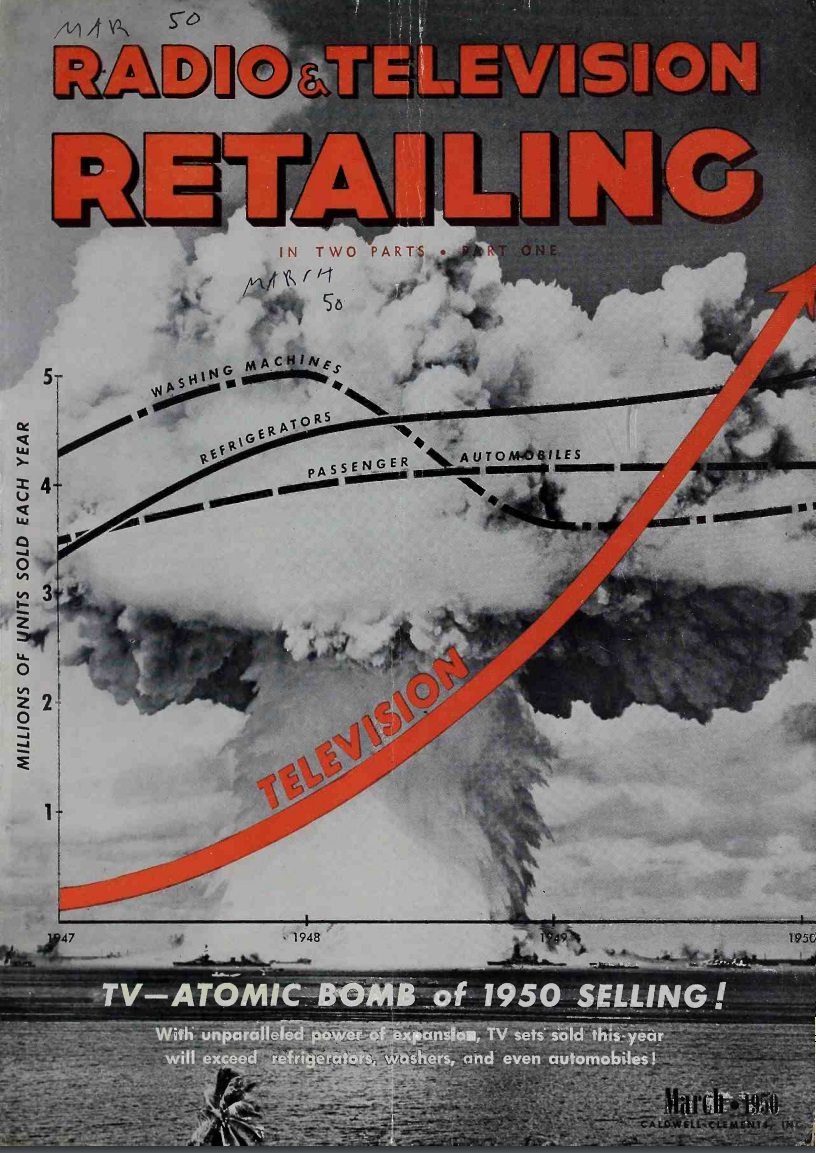 Seventy-five years ago this month, the cover of the March 1950 issue of Radio Retailing cheerfully predicted that television sales would be the atomic bomb of the year! TV sales were set to outpace refrigerators, washers, and even automobiles.
Seventy-five years ago this month, the cover of the March 1950 issue of Radio Retailing cheerfully predicted that television sales would be the atomic bomb of the year! TV sales were set to outpace refrigerators, washers, and even automobiles.